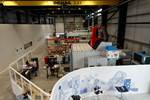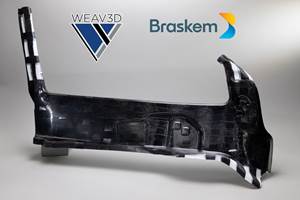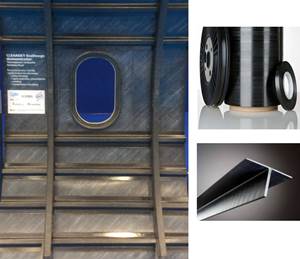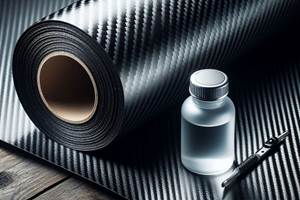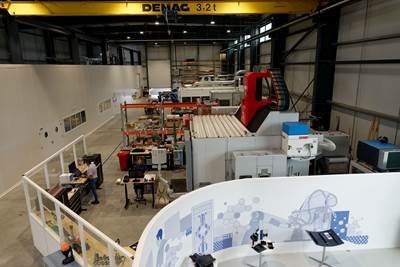Tabbing composite test specimens: When and why
Dr. Don Adams (Wyoming Test Fixtures Inc., Salt Lake City, Utah) discusses when and why test specimens must be protected by tabs.
A composite material is tabbed prior to testing, typically, for one of two reasons: to protect the material from damage from applied loads during the test or to increase the area of the loading region and, thus, reduce local stress concentrations. In general, the stronger and more highly orthotropic the composite material, the greater the need for tabbing. High-strength unidirectional composites, for example, are usually tabbed.
Many of the testing problems that tabs minimize are independent of the type of loading. Therefore, I’ll deal with most of them in a discussion of tensile loading and then deal with a few aspects that are unique to compression loading.
Tensile specimens: Fig. 1 is an edge-view sketch of a typical tensile specimen. For this type of loading, the primary purpose of the tabs is to protect the composite material from damage by the grips that clamp the specimen ends to apply the axial tensile load. This axial load is introduced into the composite via shear, due to the frictional forces developed between the grip faces and the surfaces of the tabs. But to develop the high shear force required, a high normal clamping force must be applied by the grips, which induces undesirable through-the-thickness compressive stresses in the composite material.
The primary geometric variables of the tabbed specimen are the composite material, the thicknesses of the tab and the adhesive bond line, the tab length and the tab taper angle. The material variables are the stiffness and strength of both the tabbing material and the adhesive. Each of these variables independently influences the test results. However, general statements can be made:
- Both the tabbing material and the adhesive should be as compliant (soft) as possible without losing the strength necessary to transfer the loads from the grips to the specimen’s gage section (the specimen length unsupported by the loading grips). This always involves a trade off because the softer materials will tend to exhibit lower strengths.
- The tabbing material should have toughness sufficient to withstand the harsh tearing action of the grip faces, which are typically serrated or roughened to dig into the tab surfaces, which maximizes the grips’ holding power.
- Both the tabs and the adhesive layers act as cushioning materials. Increasing the thickness of both is beneficial, but a greater benefit comes from increasing the adhesive thickness because it is the layer closest to the surface of the test material.
- Tab taper reduces the geometric discontinuity and, thus, reduces the stress concentrations in the tab termination regions. However, because the tapered regions are not held down by the grips, they curl outward when the shear loading is applied to their outer surfaces, inducing through-thickness tensile stresses in the test material to which they are bonded. For most composite materials, the through-thickness tensile strength is not very high. Therefore, these stresses can be significant, sometimes enough to cause specimen failure by pulling it apart before the desired axial tensile failure occurs.
Plain-weave glass fabric/epoxy is an excellent tabbing material. It is relatively compliant, strong and tough, and, at a thickness of 1.5 mm/0.06 inch, it is usually adequate to the task. A tab taper angle in the range of 20° to 30° is reasonable. The peel stresses are reduced as the angle is increased, but the stress concentrations tend to increase. An adhesive that has the strength of typical epoxies is usually sufficient, and a bondline thickness of 0.5 mm/0.020 inch is usually adequate, although a thickness twice that or more is acceptable. A thicker adhesive bondline will help reduce the induced stress concentrations by using a greater tab taper angle.
If tensile specimen tabbing problems are encountered despite adherence to the preceding guidelines, the first consideration should be to reduce the specimen thickness if at all possible. This reduces the applied force required to cause specimen failure and, thus, reduces the demands on the previously discussed testing parameters.
Compression specimens: These specimens can be compression loaded in two primary ways, namely, via shear, through grips, in a manner similar to that used for tensile specimens, or by direct end loading. In both cases, when testing high-strength, highly orthotropic materials, tabs are needed. Thus, for shear loading, most of the problems and considerations are the same as for tensile loading. An important difference, however, is the potential for specimen buckling when it is loaded in compression. To reduce the risk of buckling, the gage section length should be short. How short is guided by the Euler buckling equation, modified to account for material orthotropy.1 For specimens of typical thicknesses (3 mm/0.12 inch or less), the gage length is typically 12 mm/0.5 inch or less. And because tapering the tabs reduces their capacity to support the specimen and prevent buckling, I recommend the use of untapered, fully gripped tabs. The compliance of the untapered tabs and the thickness of the adhesive must be relied upon to reduce the geometry-induced stress concentrations in the specimen.
If an untabbed specimen of high strength, highly orthotropic material is directly end-loaded, it will end-crush. For that reason, tabs are used to increase the load-bearing area. Again, to minimize buckling in the gage section the tabs are not tapered and the unsupported length is kept short. However, gross buckling (buckling of the entire specimen) also must be prevented. Thus, some type of lateral constraint fixture can be used — perhaps something as simple as two stiff plates lightly bolted together with the tabbed specimen sandwiched between them.
The relative stiffness of the two materials and their relative thicknesses determine how much of the end load is introduced directly into the composite material and how much is introduced into the tabs. It is desirable to apply as much of the load as possible directly into the composite ends because these regions are the farthest from the gage section. The load introduced into the tabs must be transferred via shear from the tabs to the adhesive along the tab length and, ultimately, into the specimen. If the test situation requires too much load transfer, the result could be increased stress concentrations in the tab termination region or even tab and/or adhesive failure.
Next time: Dr. Adams will outline “Tabbing composite test specimens: The how,” where he will discuss specific tabbing techniques. In the meantime, readers can access additional help with general specimen tabbing at the Federal Aviation Admin. Web site.2
Wyoming Test Fixtures Inc.
References
1ASTM Standard D3410-03 (2008), “Compressive Properties of Polymer Matrix Composite Materials with Unsupported Gage Section by Shear Loading,” ASTM International (W. Conshohocken, Pa.).
2D.O. Adams and D.F. Adams, “Tabbing Guide for Composite Test Specimens,” Federal Aviation Admin. Report No. DOT/FAA/AR-02/106, October 2002, online at http://www.tc.faa.gov/its/worldpac/techrpt/ar02-106.pdf.
Related Content
Braskem demonstrates PP solutions using Weav3D composite lattice technology
Partnership combines Braskem’s polypropylene sheets with Weav3D Rebar for Plastics technology to address new structural, automotive applications requiring high-strength, lightweight material solutions.
Read MorePEEK vs. PEKK vs. PAEK and continuous compression molding
Suppliers of thermoplastics and carbon fiber chime in regarding PEEK vs. PEKK, and now PAEK, as well as in-situ consolidation — the supply chain for thermoplastic tape composites continues to evolve.
Read More3D-woven composites find success in aerospace, space
CAMX 2024: Bally Ribbon Mills experts are displaying the company’s various joints, thermal protection system (TPS) technologies and other 3D woven composites for mission-critical applications.
Read MoreComposite resins price change report
CW’s running summary of resin price change announcements from major material suppliers that serve the composites manufacturing industry.
Read MoreRead Next
Developing bonded composite repair for ships, offshore units
Bureau Veritas and industry partners issue guidelines and pave the way for certification via StrengthBond Offshore project.
Read MorePlant tour: Daher Shap’in TechCenter and composites production plant, Saint-Aignan-de-Grandlieu, France
Co-located R&D and production advance OOA thermosets, thermoplastics, welding, recycling and digital technologies for faster processing and certification of lighter, more sustainable composites.
Read More“Structured air” TPS safeguards composite structures
Powered by an 85% air/15% pure polyimide aerogel, Blueshift’s novel material system protects structures during transient thermal events from -200°C to beyond 2400°C for rockets, battery boxes and more.
Read More

